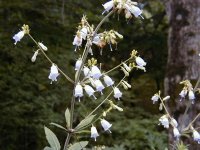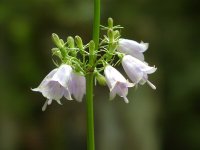Bugle whorled - adenophora verticillata fisch.
Family Campanulaceae
Other names: Bibenchik four-leaved - Adenophora tetraphylla
Botanical characteristics. Perennial herbaceous plant up to 1 m high. It grows in deciduous forests, in damp meadows, in thickets of bushes.
The root is thick wrinkled. Stem erect, smooth. Leaves are jagged, most of them on the stalk are whorled. Flowers are campanulate, dangling, collected in whorls. There are several such whorls on the stem, from 5 or more flowers. The corollas of the flowers are blue. Columns are very strongly exposed from the corolla tube. The fruit is a box, the seeds are small, oblong. Blossoms in June - July, fructifies in July - August.
Used parts of the plant. Medicinal raw materials are roots, the aerial part of the plant - flowers, leaves and seeds. Collect the plant during the whole vegetation period of the plant. Roots - in the autumn before the plant withers. Dry outdoors in the shade.
Chemical composition. All parts of the plant contain organic acids, alkaloids, flavonoids, coumarins, saponins. In addition, the roots contain carbohydrates: inulin; Triterpenoids, steroids, saponins; In the above-ground part - vitamins, tannins; In seeds - fatty oil.
Application. In folk medicine of the Far East, Nanais, Udege and Ulch, the plant is used as an antitumor agent.
Roots in the form of decoction in Chinese and Korean medicine are used as an expectorant for bronchitis, pulmonary tuberculosis, bronchial asthma, lung abscess, which is confirmed experimentally.
In Chinese medicine, the roots and the aerial part of the plant are used as antipyretic, spasmolytic, restorative, tonic, wound healing, improving digestion, with tumors of various etiology and localization, with hypertension. The above-ground part of the plant is used in Tibetan medicine for epilepsy, atherosclerosis.
In the experiment, the broth and alcohol extract have moderate anticonvulsant and pronounced antiulcer properties. Infusion of the aerial part has a bacteriostatic effect. Coumarins show antitumor activity.
Infusion of flowers and leaves used in folk medicine for skin diseases in the form of poultices and lotions, for rinsing the mouth with inflammation of the mucous membrane and gums.
The powder of the root is covered with wounds and sores. Fresh juice is used to treat the scalp, to strengthen and grow hair, both inside and outward.
Roots and young shoots are suitable for food in a raw and boiled form. Seeds are used as a seasoning for meat dishes.
Preparation
- For broth take 30 g of roots, chop, pour 200 ml of boiling water, insist on a boiling water bath for 15 minutes, cool for 25 minutes, filter. Take 1/3 cup 3 times daily before meals.
- Fresh juice is taken orally and externally in a ratio of 1: 5, inside by 1 tbsp. Spoon before eating, squeezed a little water (20-25 ml).
- From the roots, you can make a tincture on 70% alcohol at a rate of 1: 5, insist 18-20 days in a dark place, filter. Take 1 tsp 3 times a day before meals.




Comments
Commenting on, remember that the content and tone of your message can hurt the feelings of real people, show respect and tolerance to your interlocutors even if you do not share their opinion, your behavior in the conditions of freedom of expression and anonymity provided by the Internet, changes Not only virtual, but also the real world. All comments are hidden from the index, spam is controlled.